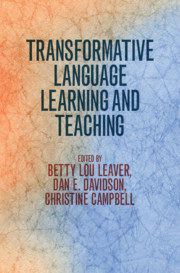Book contents
- Transformative Language Learning and Teaching
- Transformative Language Learning and Teaching
- Copyright page
- Contents
- Figures
- Tables
- Contributors
- Foreword
- Acknowledgments
- Abbreviations
- 1 Introduction
- Part I Theoretical Framework
- Part II Transformative Language Learning and Teaching Applications in Government Programs
- Part III Transformative Language Learning and Teaching Applications in University Programs
- 8 Authentic Resources and Written Reflection as Contributors to Transformative Learning
- 9 The Community as Transformative Classroom
- 10 Cultural Transformation
- 11 Designing Learning Environments to Facilitate Transformative Language and Culture Learning in a US Language Flagship Program
- Part IV Transformative Language Learning and Teaching Applications in Immersion Programs
- Part V The Learner
- Part VI Faculty Development
- Part VII Assessment
- References
- Index
8 - Authentic Resources and Written Reflection as Contributors to Transformative Learning
from Part III - Transformative Language Learning and Teaching Applications in University Programs
Published online by Cambridge University Press: 26 January 2021
- Transformative Language Learning and Teaching
- Transformative Language Learning and Teaching
- Copyright page
- Contents
- Figures
- Tables
- Contributors
- Foreword
- Acknowledgments
- Abbreviations
- 1 Introduction
- Part I Theoretical Framework
- Part II Transformative Language Learning and Teaching Applications in Government Programs
- Part III Transformative Language Learning and Teaching Applications in University Programs
- 8 Authentic Resources and Written Reflection as Contributors to Transformative Learning
- 9 The Community as Transformative Classroom
- 10 Cultural Transformation
- 11 Designing Learning Environments to Facilitate Transformative Language and Culture Learning in a US Language Flagship Program
- Part IV Transformative Language Learning and Teaching Applications in Immersion Programs
- Part V The Learner
- Part VI Faculty Development
- Part VII Assessment
- References
- Index
Summary
For language teachers who are already convinced about why to include transformative learning goals, this chapter will help to clarify what we know about how these sometimes-elusive learning goals can be scaffolded within our existing instruction. Language teachers interested in including transformative learning goals in their language classes should know that the transformative process is difficult to predict and to measure. However, instructors can intentionally and even successfully nurture transformation without straying far from widely accepted classroom practices by taking a more critical approach. Authentic texts can be useful for promoting disorienting dilemmas when they are at the learners' cognitive and proficiency level and include feasible tasks. Critical reflection is also essential to transformative learning and can be encouraged through structured written reflection. This reflection can take place in the L1 or L2. Finally, instructors can motivate students to take action by asking them to think about next steps.
Keywords
- Type
- Chapter
- Information
- Transformative Language Learning and Teaching , pp. 71 - 79Publisher: Cambridge University PressPrint publication year: 2021



